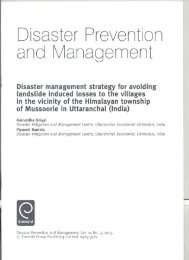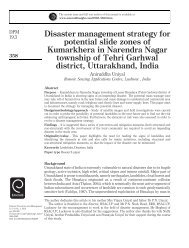Prognosis and mitigation strategy for major landslide-prone areas Varunavat Parvat landslide in Uttarkashi
Prognosis and mitigation strategy for major landslide-prone areas A case study of Varunavat Parvat landslide in Uttarkashi township of Uttarakhand (India)
Prognosis and mitigation strategy for major landslide-prone areas A case study of Varunavat Parvat landslide in Uttarkashi township of Uttarakhand (India)
Create successful ePaper yourself
Turn your PDF publications into a flip-book with our unique Google optimized e-Paper software.
Waste management<br />
Clear-cut policy should be <strong>for</strong>mulated <strong>for</strong> the waste management of hill slopes<br />
particularly <strong>for</strong> the planned disposal of debris material generated from the slope cutt<strong>in</strong>g<br />
or digg<strong>in</strong>g <strong>for</strong> construction activity. As the slope cut debris not only blocks the natural<br />
dra<strong>in</strong>s butevengives rise tonewslide zones <strong>and</strong>damages agriculture <strong>and</strong><strong>for</strong>estresources<br />
of the immediate down slope area. Separate funds <strong>for</strong> planned disposal of road cut debris<br />
should be allocated to the agencies (such as Public Works Department) <strong>in</strong>volved <strong>in</strong> the<br />
road construction work. Furthermore, the expenditure to be <strong>in</strong>curred by the concerned<br />
department <strong>for</strong> the disposal of slope cut/ road cut debris should be proposed <strong>in</strong> the project<br />
estimate itself. This measure can substantially reduce the risk of l<strong>and</strong>slides <strong>and</strong><br />
subsidence to the immediate upslope <strong>and</strong> down slope <strong>areas</strong> of newly constructed hill<br />
roads <strong>and</strong> can also m<strong>in</strong>imize the annual ma<strong>in</strong>tenance cost of hill roads.<br />
Avoidance of ground-water harvest<strong>in</strong>g structures <strong>in</strong> the old slide zones<br />
Recharge wells <strong>and</strong> ground-water harvest<strong>in</strong>g structures should be avoided <strong>in</strong> the<br />
upslope <strong>areas</strong> of old <strong>and</strong> active slide zones where<strong>in</strong> habitations or critical facilities are<br />
located (over old slide zones).<br />
Ra<strong>in</strong>fall database creation<br />
Detailed database <strong>for</strong> ra<strong>in</strong>fall needs to be created <strong>in</strong> an attempt to workout the<br />
threshold amount of ra<strong>in</strong>fall that might cause slide or debris flow <strong>in</strong> the near future.<br />
For this purpose there is an urgent need to <strong>in</strong>crease the number of ra<strong>in</strong> gaze stations <strong>in</strong><br />
hill districts.<br />
L<strong>and</strong>slide risk mapp<strong>in</strong>g at municipality ward <strong>and</strong> village level<br />
L<strong>and</strong>slide hazard zon<strong>in</strong>g at municipality ward <strong>and</strong> village Level on 1:4000 <strong>and</strong> larger<br />
scale should be carried out through conjunctive use of high resolution satellite image of<br />
IKONOS, QUICKBIRD, CARTOSAT 1 <strong>and</strong> CARTOSAT 2 satellites <strong>and</strong> precision<br />
ground surveys us<strong>in</strong>g Total Station. Furthermore, the GIS techniques can be best<br />
utilized <strong>for</strong> vulnerability assessment by overlay<strong>in</strong>g the thematic layers of population,<br />
<strong>in</strong>frastructure, assets <strong>and</strong> natural resources over the l<strong>and</strong>slide hazard zone maps of the<br />
area. Risk maps at municipality ward <strong>and</strong> village Level should be created by relat<strong>in</strong>g<br />
the l<strong>and</strong>slide hazard potential <strong>and</strong> vulnerability of the area. Risk maps can provide<br />
<strong>in</strong><strong>for</strong>mation about the likelihood, dimension, extent <strong>and</strong> degree to which the<br />
communities <strong>in</strong> the area may be affected by l<strong>and</strong>slides.<br />
References<br />
Agarwal, N.C. <strong>and</strong> Kumar, G. (1973), “Geology of the upper Bhagirathi <strong>and</strong> Yamuna valleys,<br />
<strong>Uttarkashi</strong> district, Garhwal Himalaya”, Himalayan Geology, Vol. 3, pp. 2-23.<br />
Census of India 2001 (2004), Census of India 2001, Office of Registrar-General, New Delhi.<br />
Central Technical Team (2003), “Interim report on <strong>Varunavat</strong> l<strong>and</strong>slide, <strong>Uttarkashi</strong><br />
(Uttaranchal)”, unpublished technical report, Central Technical Team, Governement of<br />
India, New Delhi.<br />
DMMC (2003), “F<strong>in</strong>al report on l<strong>and</strong>slide affected Gyansu <strong>and</strong> Tambakhari area of <strong>Uttarkashi</strong>”,<br />
Technical Report No. DMMC<strong>Uttarkashi</strong>:2003:1-570, unpublished tech. report of Disaster<br />
Mitigation <strong>and</strong> Management Centre, Dehradun.<br />
<strong>Prognosis</strong> <strong>and</strong><br />
<strong>mitigation</strong><br />
<strong>strategy</strong><br />
643





